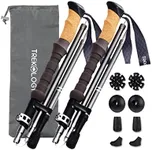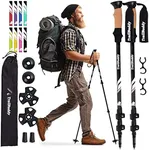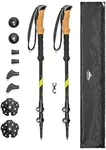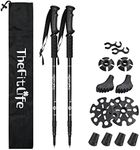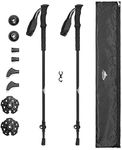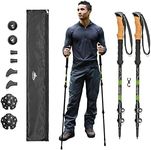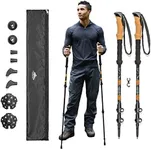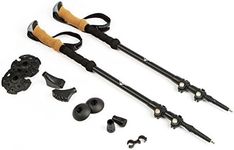Buying Guide for the Best Hiking Poles Carry On
Choosing the right hiking poles for carry-on travel is all about balancing portability, comfort, and durability. Since you'll be taking these poles on flights, it's important to consider how easily they pack down and whether they meet airline regulations for carry-on luggage. At the same time, you want poles that will support you well on the trail and last through many adventures. Understanding the key features will help you find hiking poles that fit your travel style and hiking needs.Collapsed LengthCollapsed length refers to how short the hiking poles become when fully folded or retracted. This is crucial for carry-on travel because airlines have size restrictions for luggage, and your poles need to fit inside your bag or meet their requirements. Poles with a shorter collapsed length (usually under 22 inches or 55 cm) are easier to pack and more likely to fit in a standard carry-on. If you travel often or use smaller bags, look for the shortest collapsed length possible. If you only occasionally fly or have a larger carry-on, you might be able to use slightly longer poles.
Folding MechanismThe folding mechanism describes how the poles break down for storage. There are generally two types: telescoping (where sections slide into each other) and folding (where sections are connected by a cord and fold up like tent poles). Folding poles usually pack down smaller, making them ideal for carry-on, while telescoping poles may be a bit longer but can offer more adjustability. If compactness is your top priority, folding poles are a great choice. If you want more flexibility in length adjustment, telescoping poles might suit you better.
WeightWeight is how heavy the poles are, usually measured per pair. Lighter poles are easier to carry, especially when traveling or hiking long distances. However, very lightweight poles may sacrifice some durability or stability. If you plan to hike for many hours or need to save space and weight in your luggage, go for lighter poles. If you need extra support or expect rough terrain, a slightly heavier but sturdier pole could be better.
MaterialThe material of the poles affects their weight, strength, and price. Common materials are aluminum and carbon fiber. Aluminum poles are generally more durable and can handle rough use, but they are heavier. Carbon fiber poles are lighter and absorb vibrations better, but they can be more fragile if bent. If you prioritize durability and don't mind a bit of extra weight, aluminum is a good choice. If you want the lightest option for easy travel and gentle hiking, carbon fiber may be best.
Grip TypeGrip type refers to the material and shape of the handle. Common materials include cork, foam, and rubber. Cork grips are comfortable, absorb sweat, and mold to your hand over time. Foam grips are soft and lightweight, while rubber grips are durable and good for wet conditions. If you hike in hot weather or for long periods, cork or foam may be more comfortable. For wet or cold conditions, rubber grips can provide better control.
AdjustabilityAdjustability means how much you can change the length of the poles. Some poles are fixed length, while others can be adjusted to fit your height or the terrain. Adjustable poles are more versatile, letting you shorten them for uphill climbs and lengthen them for descents. If you want one set of poles for different types of hikes or to share with others, adjustable poles are a smart pick. If you always hike the same way and want the lightest, most compact option, fixed-length poles might work.
